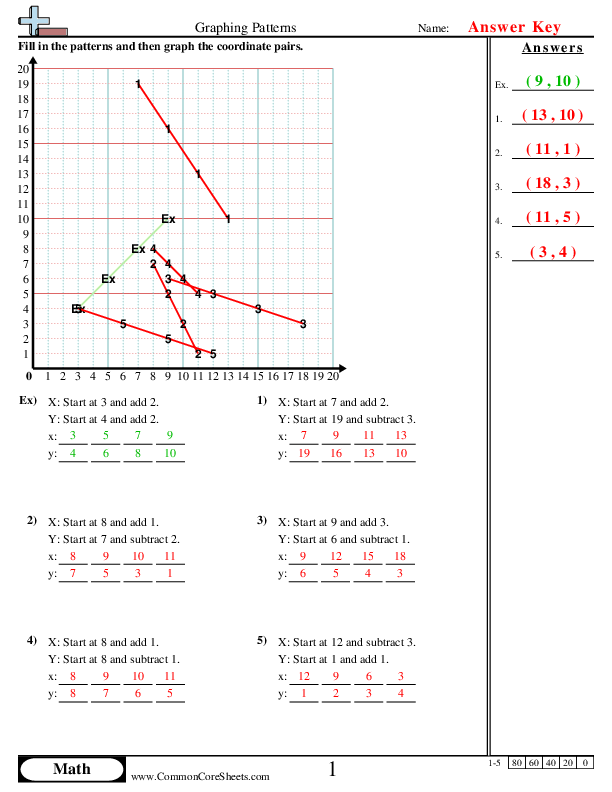Our graphing worksheets are the best on the internet for helping students learn how to graph data and interpret the results. These free worksheets cover a wide range of topics, including graphing positive and negative coordinates, reading a coordinate plane and many more. Our worksheets are designed to be easy to use and understand, making them perfect for students of all ages. Whether you're a teacher looking for the best graphing worksheets to use in your classroom, or a student looking to improve your graphing skills, these worksheets are the perfect resource. So why wait? Start using our graphing worksheets today and see the difference they can make in your understanding of this important topic!
Browse Sheets By Problem Type
×
Determining Coordinates
Link
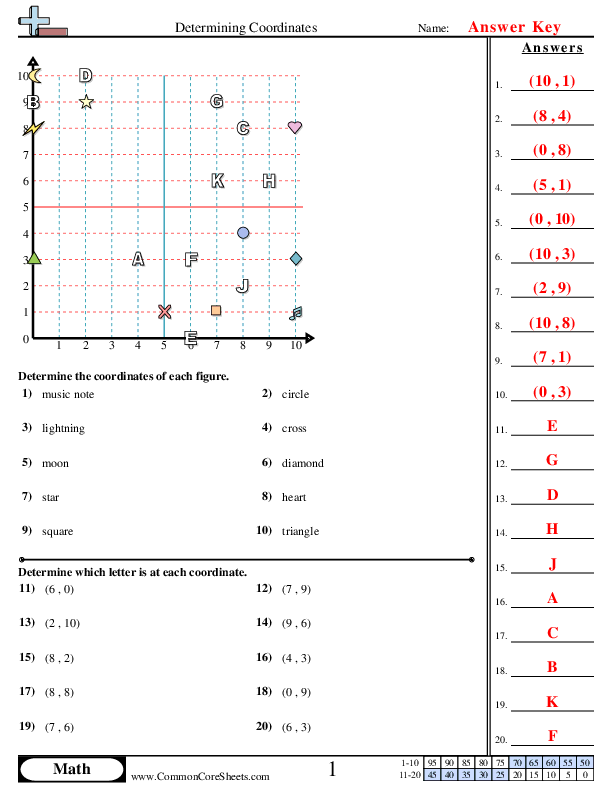
All positive coordinates
5g2


×
Description:
"This worksheet is designed to fortify children's understanding of coordinates in math through a variety of shapes and symbols. Comprising 20 problems, ranging from squares and stars to unique shapes like a music note and lightning, it enhances problem-solving skills. Ideal for distance learning, this worksheet can be customized based on unique learning needs and even converted into flashcards for dynamic study sessions."

×
Student Goals:
Enhance Analytical SkillsBy successfully completing the coordinates worksheet, students get the opportunity to enhance their analytical skills. Analyzing and interpreting the patterns of coordinates can be a challenging task, but doing so can significantly improve a child's ability to think critically and logically.Develop Problem-Solving SkillsWorking on the problems in this worksheet will promote problem-solving skills among students. Each problem is different, requiring them to think in varying ways to find the solutions. Such exercises contribute to their capability to handle more complex problems in the future.Improve Geometry KnowledgeThis worksheet allows students to explore different geometric shapes and structures. In the process, they will gain a better conceptual understanding of basic geometry. They will be able to recognize and differentiate between various shapes such as circles, triangles, squares, etc., which are fundamental in the study of geometry.Strengthen Mathematical VocabularyStudents will undoubtedly strengthen their mathematical vocabulary upon completion of this worksheet. The exercise introduces and reinforces geometry-related terms and concepts. This improved familiarity with the language of mathematics better prepares them for future mathematical studies.Boost ConfidenceSuccessfully determining coordinates and navigating the problems in the worksheet helps build confidence in a child's mathematical capabilities. With every problem they solve, their self-assurance will grow, instilling in them the belief that they can tackle complex mathematical problems or any challenges they might face in their academic journey.Promote Attention to DetailThe worksheet encourages precision and attention to detail. Students will need to pay careful attention to each coordinate and shape to arrive at the correct answer. This focus on precision will help them excel not just in mathematics, but in all areas requiring attention to detail.Develop Coordinate Plane UnderstandingLastly, completing the worksheet should equip students with a solid foundation in understanding the coordinate plane. This is a valuable skill in mathematics, which will be useful in later studies, especially in subjects like calculus, physics, and more advanced geometry.


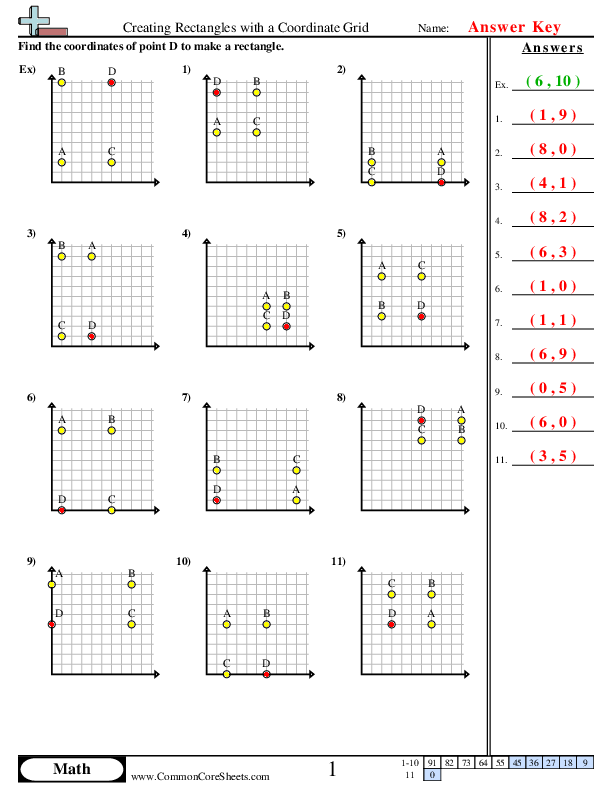
Creating Rectangles with a Coordinate Grid
5g1


×
Description:
"This worksheet is designed to help children master the concept of creating rectangles using coordinate grids. With 11 practice problems, it offers hands-on math learning in a clear, interactive way. The worksheet can be customized according to individual student needs, transformed into flash cards for quick revision or incorporated into distance learning programs. It's a versatile and practical tool for educators and students alike."

×
Student Goals:
Understanding Coordinate Grid ConceptsUpon completion of the 'Creating Rectangles with a Coordinate Grid' worksheet, students should have developed an appreciation and understanding of coordinate grid concepts in maths, specifically regarding rectangle plotting and formation. They will possess the knowledge and confidence to plot vertices of rectangles using an X-Y coordinate grid. With this competency, students will be able to create rectangles on given coordinates and understand how the position of specific points on the coordinate grid creates different forms of rectangles.Improvement in Problem Solving SkillsEnhancement in problem-solving skills will be a significant accomplishment after the completion of the worksheet. The worksheet, having eleven problems, provides students with various scenarios where they leverage critical thinking and reasoning abilities to create rectangles using the coordinate grid. With the practice of different problem sets, students will gain the ability to solve complex rectangle plotting issues and decode problems related to the geometric aspect of mathematics.Enhancement in Geometrical SkillsGeometrical skills are at the heart of this exercise. By correctly forming rectangles on a coordinate grid, students demonstrate their ability to recognize shapes and their properties, improving their geometric aptitude. As young learners navigate this exercise, they also implicitly bolster their understanding of the importance of angle calculation, symmetry, spatial reasoning in rectangles, and knowledge that will be beneficial in further geometrical studies.Development of Analytical SkillsAnalytical skills are another key area of development for students completing this worksheet. Decoding the position of vertices helps in enhancing deductive reasoning skills and honing attention to detail. This analytical awareness will also enable students to draw conclusions about rectangular shapes and develop hypotheses about other geometric shapes.Boost in ConfidenceFinally, a boost in confidence is inevitable after successfully completing the worksheet. Conquering new concepts, applying them through problems, and perfecting their understanding ultimately leads to a sense of achievement and boost in belief level. Therefore, the worksheet plays a significant role in boosting the confidence that they will carry into other areas of their academic study and beyond.



Reading a Coordinate Plane
5g1


×
Description:
"This worksheet is designed to bolster children's understanding of coordinate planes in mathematics. It houses 15 problems that challenge students to identify shapes positioned at given coordinates. Besides reinforcing key math concepts, the worksheet offers flexibility; it can be customized to meet individual learning needs, transformed into flashcards for easier assimilation, or adapted for distance learning environments. A perfect tool for comprehensive and engaging math education."

×
Student Goals:
Identification of Coordinate PlanesUpon completion of this worksheet, students should be able to effectively identify coordinate planes. They will be familiar with the correlation between a set of coordinates and its corresponding location on the coordinate plane, enhancing their ability to translate numerical information into a visual representation. This knowledge is fundamental to many areas of mathematics, especially geometric and algebraic understanding.Analytical SkillsStudents will have honed their analytical skills, given that interpreting coordinate planes requires an understanding of the relationship between two dimensions. Working through the 15 problems in this worksheet will foster strategic thinking and problem-solving abilities, underpinning their confidence to tackle more complex mathematical problems in future.Mastering Mathematical ConceptsCompletion of this worksheet will indicate mastery of the concept of coordinate planes, an integral part of the geometry curriculum. The proficiency gained in visualizing mathematical relationships and functional interactions is crucial not just in math, but also in numerous areas in the sciences, such as physics and computer science.Fundamental Metric InterpretationStudents will be practiced in interpreting fundamental metric coordinates, an important skill that finds application in real-world scenarios. These can range from reading maps in geography to interpreting data points on graphs in business, economics or scientific research. This trans-disciplinary skill will render their mathematical abilities more tangible and applicable to diverse fields.Independent Study and ConfidenceBy completing these problems independently, students will build confidence in their mathematical abilities. They'll be encouraged in their self-directed learning, which will promote resilience in future academic pursuits. The mastery and confidence students gain through this worksheet will leave them well-placed to tackle more complex maths topics with assurance and aplomb.



Marking Locations on a Grid
5g1


×
Description:
"This worksheet is designed to hone math skills by teaching children spatial awareness through marking locations on a grid. It features 12 problems, invaluable for developing students' understanding of coordinate systems. It's adaptable - it can be customized to challenge different ability levels or turned into flashcards for interactive study. An ideal tool for distance learning, it facilitates independent practice in a focused, engaging way."

×
Student Goals:
Build Spatial Recognition SkillsStudents who complete this worksheet should develop superior spatial recognition abilities. Spatial recognition is a vital part of mathematical understanding, especially in the field of geometry. This worksheet enables students to understand the layout of a grid, a foundational component of many mathematical concepts. It aids students in recognizing the horizontal and vertical axes on a grid and how they combine to form coordinates. This is a critical step in enhancing their spatial vision and their capacity to understand and describe the space around them.Enhance Problem-Solving SkillsThis worksheet will also play a crucial role in strengthening students' problem-solving skills. They're tasked with identifying and marking multiple specific locations on a grid, which promotes their ability to address issues individually and successfully. This interactive task encourages self-reliance and confidence in their problem-solving capabilities, which are essential skills in quantitative subjects like mathematics, but also have useful applications in day-to-day life.Comprehend and Use Mathematical LanguageBy marking locations on the grid, students should achieve a more thorough comprehension of mathematical language, particularly the terminology and principles related to coordinates and grids. Understanding this jargon is essential to communicating mathematical ideas and methods, as well as interpreting problems. The completion of this worksheet is a step towards fluency in mathematical language, which will be invaluable in more advanced study.Reinforce Coordinate System KnowledgeThe worksheet specifically focuses on the coordinate system, a fundamental aspect of mathematics. Therefore, students who complete this worksheet should learn or reinforce their capacity to read, understand, and utilize this system. Using a pair of numbers to represent a point in space is an abstract concept, and by physically marking these points on a grid, the idea becomes more concrete for students. This supports learning, retention, and future use of the coordinate system.Promote Accuracy and Attention to DetailLastly, this worksheet should enhance students' accuracy and attention to detail. It's essential to place the points precisely in the right spot to get the correct answer. Thus, the task encourages a thorough and careful approach to work, traits that are not only important in mathematics but also highly valued in many aspects of life


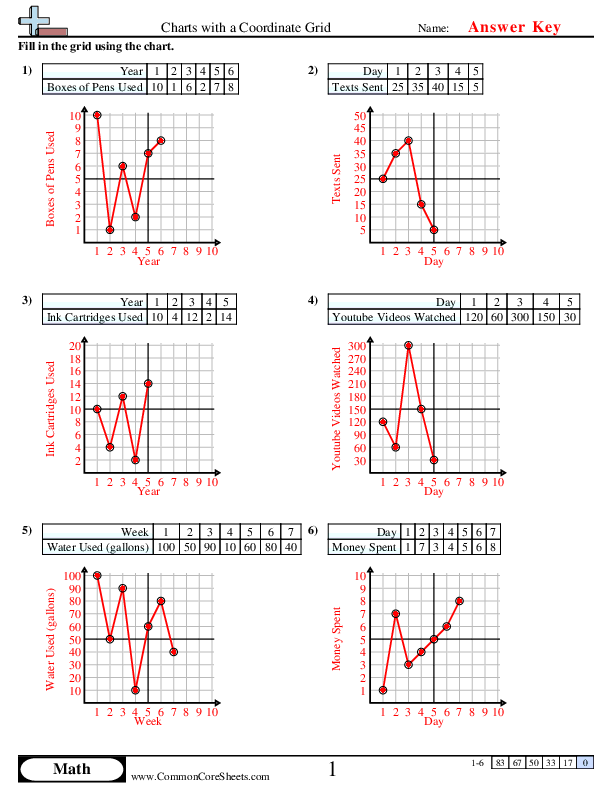
Charts with a Coordinate Grid
5g2


×
Description:
"This worksheet is designed to enhance children's understanding of math through engaging problems related to coordinate grid charts. Six distinct problems tackle concepts such as days and meals sold, weekly TV watched hours, sales hourly rates, weekly water usage, daily YouTube video consumption, and yearly pen use. It's customizable to meet individual learning needs, perfect for converting into flashcards, and fits seamlessly into distance learning methodologies."

×
Student Goals:
Develop Mathematical SkillsAfter completing the worksheet, students will be able to enhance their mathematical skills. This process will help them understand numerical concepts better and apply them in different contexts. They will be capable of working with numbers in a more analytical way. The experience will add to their cognitive abilities, letting them realize patterns, relationships, and logic in a mathematical framework.Understand Coordinate GridThe worksheet will help students comprehend the concept of a coordinate grid. They will understand how to plot numbers on a grid, recognize the importance of coordinates and their location. This will allow them to interpret data in a more visual form. The ability to present data on charts will enable simplified complexity in the information to be understood more easily.Improve Problem SolvingThis assignment will sharpen the students' problem-solving abilities. They will learn how to approach mathematical problems methodically, which will enhance their decision-making process. By solving different types of problems, students will gain a range of strategies that can be adopted to crack mathematical puzzles.Interpret Data and GraphsAfter going through the exercises, students will develop an improved ability to interpret data and graphs. They will learn how to read, understand and analyze the data presented in various graph forms. They will be able to decipher the purpose of display graphics, interpret the significant data points, and draw accurate conclusions from the visual representations of numerical data.Enhance Logical ReasoningFinishing this worksheet will contribute to honing students' logical reasoning. By manipulating numbers and analyzing patterns, they will be able to develop coherent arguments and improve their capacity to think logically. This skill will help students beyond mathematics, assisting them in all subjects that require logic and reasoning.Application of Practical Life ConceptsFinally, the tasks will let students apply mathematical concepts to everyday life. The charts and grids present data on common subjects like calories burned, water used, and so on. This encourages students to think of math as not just an abstract field of study but as a practical tool that can be used to understand and navigate the world around them.


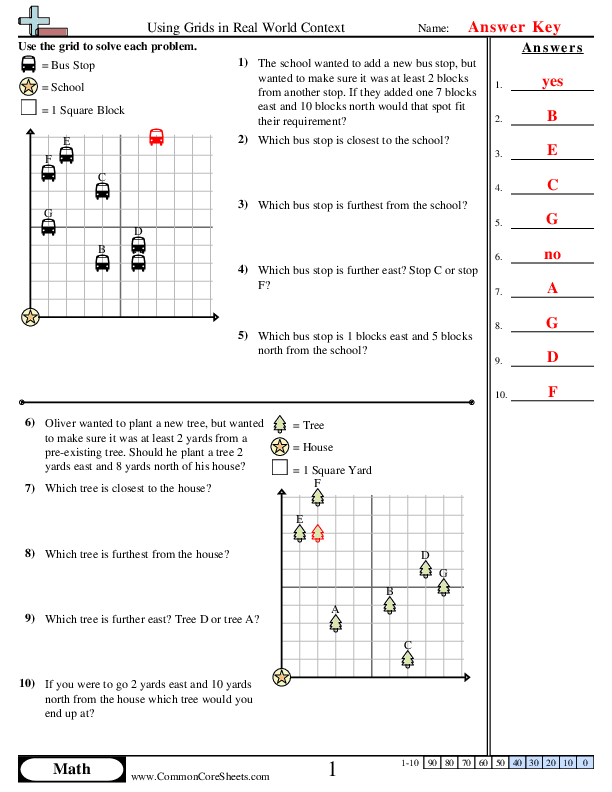
Using Grids in Real World Context
5g2


×
Description:
"This worksheet is designed to enhance children's practical understanding of grids through real-world scenarios, using a set of 10 math problems. It focuses on spatial concepts, such as distance and coordinates. The problems presented can be easily customized, converted into flashcards, or adapted for distance learning, offering versatile solutions to make grid learning engaging and effective."

×
Student Goals:
Understanding the Concept of GridsStudents will develop a basic understanding of the concept of grids after completing this worksheet. They should be able to recognize grids as a tool for locating points within a given area, as well as be familiar with the terms 'east', 'west', 'north', 'south' as they relate to grid navigation.Application of Mathematical ConceptsStudents will be able to successfully apply mathematical concepts by interpreting and solving problems that involve distances and location. They should be able to differentiate between distances closer and further from a certain point. This worksheet makes them adept at handling practical mathematical problems common in real-life scenarios, such as determining the placement of a bus stop or a well using a set of given rules.Developing Analytical and Planning SkillsBy completing this worksheet, students will learn to use analytical and planning skills to solve problems. They will understand how decisions are made attending to specific criteria and they will be able to make inferences, analyses, and predictions based on the information available on the grid.Improving Critical Thinking SkillsThe worksheet fosters the enhancement of critical thinking skills. Students should be able to process the provided information, make informed decisions, and offer possible solutions to problems. These skills are essential in today's rapidly changing world, not only in academics but also in everyday life challenged with complex scenarios.Boosting Sarial ReasoningThis worksheet will enhance the students' spatial reasoning abilities. They will become more adept at using grids to locate directions and comprehend the relative positions of different points, understanding the relationships between different objects and spaces.Better Problem-Solving AbilitiesThe worksheet enables the students to strengthen their problem-solving skills. They will learn to identify the problem, decipher the underlying requirements, apply appropriate methods, and arrive at solutions. They will become more proficient at solving various types of problems involving distances and locations on a grid.


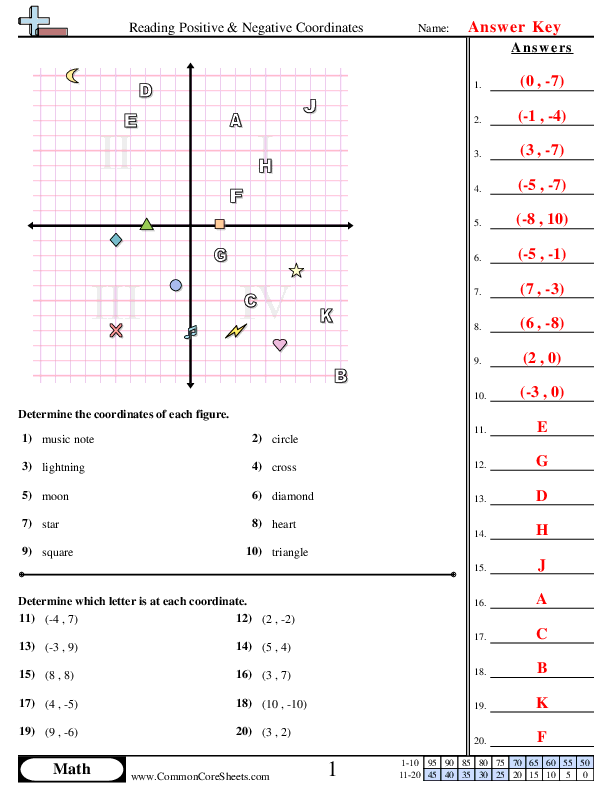
Positive and Negative
6ns6c


×
Description:
"This worksheet is designed to teach children the concept of positive and negative coordinates in a fun, interactive way. Using geometric shapes and familiar objects like a star, heart, or moon, this customizable worksheet presents 20 problems ideal for learning via flashcards or distance education. With practice, students will master the math skill of reading coordinates effectively."

×
Student Goals:
Understanding of Coordinate SystemUpon the successful completion of this worksheet, the students will have a deeper understanding of the positive and negative coordinate system, a crucial concept in mathematics. They will learn the basics of graphing, addressing both the x and y coordinates, and how to plot points correctly using positive and negative numbers.Improved Problem Solving SkillsWork through the entire set of problems will help the students to strengthen their problem-solving skills. The 20 problems on the worksheet have been designed in such a way that they test the students' ability to interpret and work out solutions convincingly. Each problem presents a unique challenge, further motivating students to think critically and logically.Competency in Navigating 2D SpaceThe students will demonstrate a proficiency in navigating the two-dimensional space effectively. This skill will come in handy when carrying out analytical tasks in later grades, especially in subjects that require the use of diagrams and charts such as Geometry and Physics.Application of Knowledge to Real World ScenariosThe students will be able to apply the knowledge gained from the worksheet, not just in the academic context, but also in real-life scenarios. The understanding of coordinates is beneficial in a diverse range of fields, including Computer Science, Geography, Engineering, Architecture and more. This is, therefore, a significant step in equipping them with relevant skills for the future.Enhanced Math VocabularyStudents will further solidify their math vocabulary relevant to coordinate systems, including terms like 'axis', 'origin', 'quadrant', 'coordinates', 'positive', and 'negative'. Confident use of the appropriate mathematical language helps students to communicate their understanding effectively.Confidence and Independence in LearningCompleting the worksheet will also foster a notable level of confidence and independence in the students. Attempting, solving, and correcting errors all by themselves will encourage them to take charge of their learning process and not shy away from attempting challenging problems in future.



Examining Graphs
7rp2d


×
Description:
"This worksheet is designed to improve children's competencies in math, specifically in the area of interpreting and examining graphs. It contains three engaging problem sets featuring realistic scenarios like printing pages, earning points by defeating enemies, and counting candies. These concepts are tailored to keep children interested while developing their graph reading skills. The worksheet can be customized and converted into flash cards to aid in review, and it is suitable for distance learning."

×
Student Goals:
Understanding GraphsAfter completing the worksheet, students should be able to thoroughly understand and interpret various types of graphs. They will gain in-depth knowledge of how data is represented graphically and how it translates into real-life situations. Decoding the relationship between various data points on the graph should come easily to them.Develop Mathematical SkillsThe worksheet will play a crucial role in improving students' mathematical skills. Successfully navigating through the problems will help them apply basic arithmetic operations and understand correlations. This will also aid in the development of their problem-solving approach, numerical fluency, and critical thinking.Relating Mathematics to Real-World ScenarioThe completion of the worksheet allows students to develop a vital skill - connecting mathematical concepts to everyday life situations. They will have a clearer understanding of how mathematical graphs are used to represent and decode information in various fields, enhancing their practical knowledge.Analytical SkillsStudents will foster their analytical skills as they dissect the elaborate data sets represented in the graphs. Analyzing different sets of data will allow them to draw conclusions and comparisons, boosting their analytical abilities.Attention to DetailBy working through the problems on this worksheet, students will enhance their attention to detail. They will have to closely examine the different data points and their corresponding values to solve the problems, thereby promoting precision and meticulousness in their work.Understanding of Quantitative RelationshipsThe worksheet will help students recognize and comprehend the quantitative relationship between different elements. They will be able to predict and interpret how a change in one quantity can affect another, thereby augmenting their understanding of dependent and independent variables.


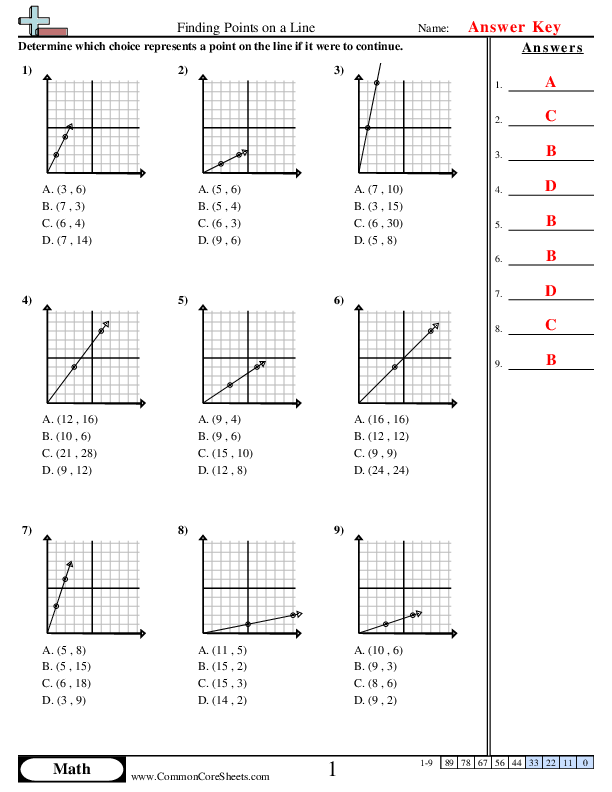
Finding Points on a Line


×
Description:
"This worksheet is designed to bolster children's mathematical skills, specifically in understanding and finding points on a line. With a set of 9 engaging problems, learners can identify patterns and relationships in different coordinates. Versatile and customizable, it can be transformed into flash cards, aiding hands-on learning, or seamlessly integrated into distance learning curriculums, thus offering flexibility in instructional delivery and enhancing children's spatial awareness in the realm of mathematics."

×
Student Goals:
Develop Mathematical UnderstandingAfter completing the worksheet, students should have enriched their mathematical comprehension, particularly concerning the concept of plotting points on a line. They will grasp the fundamentals of coordinate geometry and how it represents a system for specifying positions on a plane. This understanding will help them to excel not only in various math problems, but also in different areas of scholastic pursuit that require data visualization and spatial reasoning.Enhance Problem-Solving SkillsWorking through the problems in the worksheet, students ought to hone problem-solving skills by learning how to approach a question logically and systematically. This experience will heighten their analytical thinking skills and promote reliance on strategic planning. It will also foster resilience in the face of complex tasks, thereby encouraging them to persevere until they find solutions.Sharpen Precision and AccuracyThe completion of these exercises is an opportunity for students to develop a keen eye for precision and accuracy. Dealing with coordinates demands a meticulous approach and focuses on specific details. This trait is vital in various scientific and mathematical domains where leaving out a minute detail can significantly alter results.Gain Applied KnowledgeAfter concluding the worksheet, learners will be equipped not only with theoretical knowledge, but also with the ability to apply such knowledge in real-world scenarios. Understanding points on a line and their representations expands one's capacity in tackling graph-related contexts. This interactive, applied form of learning can connect abstract ideas to concrete experiences.Bolster Confidence in MathAs students find correct solutions to the problems provided, they should feel increased confidence in their math abilities and aptitude. This self-assurance can motivate them to take on more challenging mathematical problems and larger complexities. Moreover, it can diminish math-related anxiety and promote a positive attitude towards future mathematical endeavors.Promote Independent LearningBy providing solutions independently for this worksheet, students will have advanced their self-guided learning abilities. Such abilities play a crucial role in nurturing intellectual autonomy and instilling a lifelong love for learning. Furthermore, this fosters accountability and responsibility for their educational advancement.


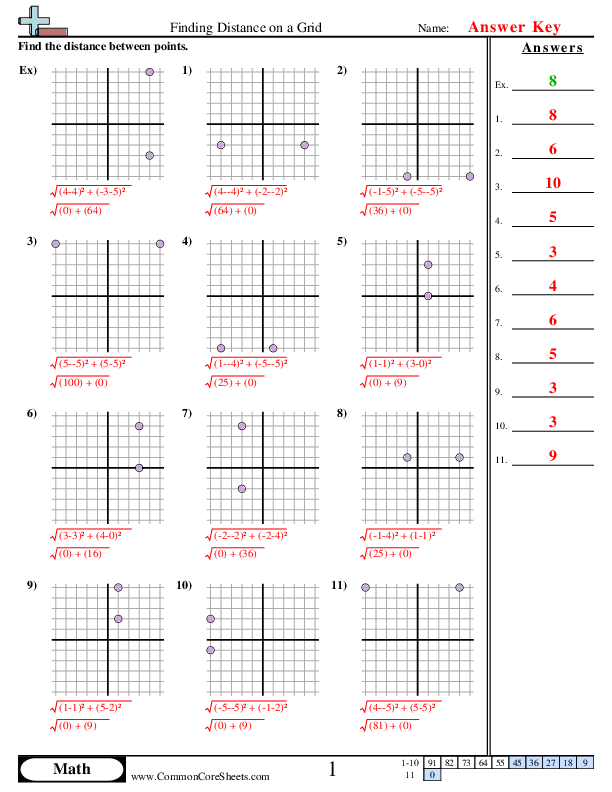
Finding Distance (Same X or Y)
6ns8


×
Description:
"This worksheet is designed to enhance children's understanding of distance calculation on a grid in mathematics. It provides 11 problem-solving tasks that guide kids through a step-by-step process of using coordinates to calculate distances. Tailored to accommodate different learning environments, the sheet can be customized for personal needs, converted into interactive flash cards, or integrated into distance learning curriculums to reinforce this crucial math concept in a fun and engaging way."

×
Student Goals:
Understanding Grid-Based CalculationsAfter completing this worksheet, students will have a better understanding of how to calculate distances within a grid. They'll have a better command of the mathematical concepts involved, bringing them closer to mastering the subject matter. Distance calculations on a grid are a critical part of mathematics and these exercises will immensely magnify their ability to handle them, pertinent to real-world applications like physical mapping, computer graphics, and data visualization.Problem Solving and Critical ThinkingBy successfully navigating through the problems in the worksheet, students will also develop enhanced critical thinking and problem-solving skills. Each task poses a unique challenge that requires careful consideration and mathematical reasoning. Thus, they will be capable of strategically tackling complex problems, developing a structured approach to break them down and derive solutions.: Proficiency in Mathematical OperationsThe worksheet addresses basic to advanced mathematical operations. Therefore, students will become more adept at executing these operations accurately and efficiently after multiple practices provided by the worksheet. Their proficiency in addition, subtraction, multiplication, and square operations will be noticeably improved.Applying Mathematical ConceptsThrough applying mathematical concepts to solve distance problems on grids, students will better understand and learn abstract mathematical ideas. Despite being simple arithmetic, the worksheet allows the students to understand the fundamentals of the coordinate system, geometry, and how to use two-dimensional spaces with ease.Enhancement of Math VocabularyIn the process of completing this worksheet, students will come across various key terms and symbols regularly used in mathematics. This exposure can lead to an expanded vocabulary in math language, enabling them to articulate mathematical problems better in the future.Confidence in MathSuccessfully completing the worksheet will help students build confidence in their mathematical abilities. Overcoming challenges and solving problems on their own will give them the confidence to approach even more complex math problems in the future, reducing math-anxiety, and cultivating a positive attitude towards the subject.


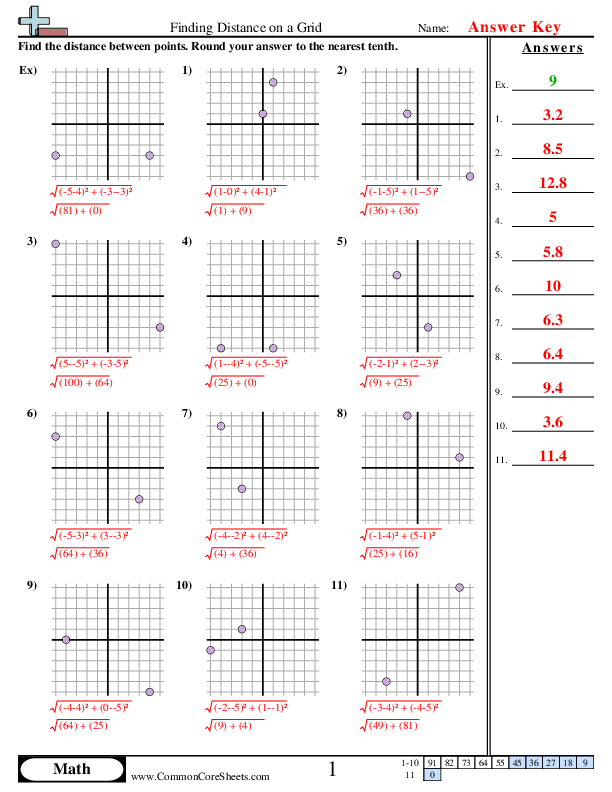
Finding Distance (Different X and Y)


×
Description:
"This worksheet is designed to teach children how to calculate distances on a grid using mathematic equations. It consists of 11 targeted math problems, effectively teaching the concept through practical application. Versatile in its purpose, it can be customized to fit varying levels of problem-solving proficiency, converted into flash cards for interactive learning or utilized in a distance learning environment for flexible mathematical education."

×
Student Goals:
Understanding of Mathematical ConceptsAfter completing the worksheet, students will deepen their understanding of mathematical concepts, such as the importance of coordinates and their relationship in determining distance on a grid. The exercises involve the use of Pythagorean theorem, enhancing their comprehension of geometrical principles and their applications.Enhanced Problem-Solving SkillsThe problems presented in the worksheet require logical thinking and reasoning. Students will be able to enhance their problem-solving skills by translating real-world concepts into a mathematical framework. They will master skills such as breaking down complex problems into simpler, more manageable parts and applying mathematical rules to solve them.Improved Numerical SkillsThe worksheet provides plenty of practice for students to work on their numerical skills. These tasks will improve the students' comfort and fluency with numbers, strengthening their ability to make quick and accurate calculations, a skill that is crucial in many areas of life beyond math.Familiarity with Grid SystemsGrid systems are ubiquitous, used in a variety of contexts from maps to spreadsheets. By finding distances on a grid system in this worksheet, students will become more familiar with the use and interpretation of grids which is a transferrable skill for fields such as data management, engineering, and navigation.Promotion of Logical and Structural ThinkingThe worksheet promotes logical and structural thinking by requiring students to apply a systematic method to solve the problems. By methodically applying mathematical formulas to find distances on a grid, students will improve their ability to think logically and in a structured manner.Ability to Work IndependentlyBy working through the exercises in the worksheet, students will improve their ability to work independently. They will familiarize themselves with strategies for approaching and solving mathematical problems, fortifying their confidence in their own abilities to work through challenges on their own.


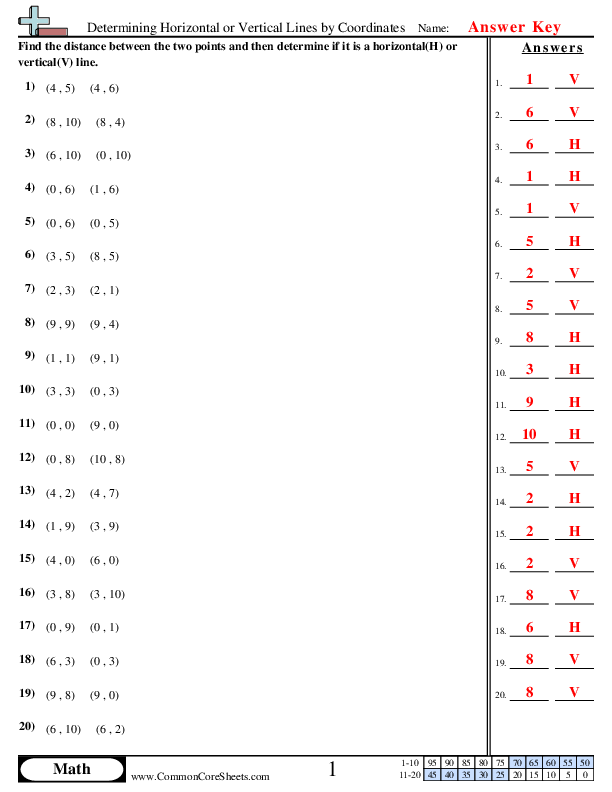
Determining Horizontal or Vertical Lines by Coordinates


×
Description:
"This worksheet is designed to help children master the concept of determining horizontal or vertical lines by coordinates. It contains 20 math problems based on pairs of coordinates. Versatile and adaptable, it can be customized to suit individual learning needs, converted into flashcards for practice, or utilized as part of distance learning programs."

×
Student Goals:
Understand Coordinates and LinesBy completing the worksheet, students will deeply understand the concept of coordinates and how to determine whether lines are horizontal or vertical. They will enhance their knowledge of the coordinate plane and strengthen their understanding of points, lines, and angles.Practice Problem SolvingThe worksheet will improve students' problem solving and reasoning skills as they learn to navigate through different sets of coordinates. This practice will enable them to identify patterns and deduce whether the line formed by two coordinates is horizontal or vertical, helping them develop critical thinking capabilities.Boost Mathematical SkillsTackling the problems in the worksheet equips the students with a strong foundation in mathematics. Their numeracy skills are reinforced as they regularly work with numbers and symbols. They will also learn important concepts in geometry that are instrumental for their academic progress in the math field.Enrich Real-life Application of MathAfter completing the worksheet, students will be equipped with the fundamental skills needed to apply their mathematical knowledge to real-world situations. Understanding coordinates and lines could be beneficial in various areas such as map reading, programming, and even in arts and engineering.Enhance Spatial AwarenessBy identifying whether lines are vertical or horizontal, the students will foster their spatial awareness skills. This understanding allows students to visualize objects from different angles and helps in many areas such as reading graphs, understanding blueprints, or visualizing geometric shapes.Improve Analytical SkillsWorking through the worksheet will also refine the students' analytical skills. Identifying patterns and drawing conclusions from the given sets of coordinates requires a systematic approach to problem solving, and the practice of these skills will be beneficial in many other academic subjects.


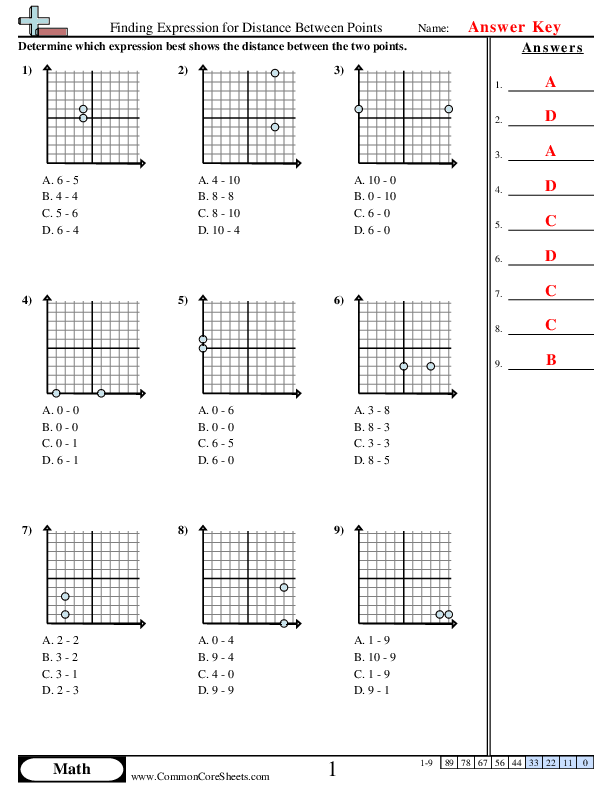
Finding Expression for Distance Between Points


×
Description:
"This worksheet is designed to strengthen children's math skills, focusing specifically on finding the expression for distance between points. It includes 9 customized problems that test and develop their comprehension through practical examples. Future adaptability allows the worksheet to be converted into flashcards or incorporated into distance learning programs, ensuring flexibility in learning and reinforcing core mathematical concepts."

×
Student Goals:
Understanding Mathematical ConceptsAfter completion of the worksheet, students should have an understanding of key mathematical elements. They should be able to appreciate the principles involved in the concept of distance between two points, which forms a foundational Math concept for complex topics in higher grades. They should understand how arithmetic operations like subtraction are used in determining distances, and be comfortable dealing with positive and negative numbers.Developed Problem-solving SkillsThe worksheet also aims to improve students' problem-solving abilities. The nature of the questions requires them to apply cognitive skills and logic to find the correct answers. By tackling these problems head-on, students should be able to sharpen their critical thinking skills further, which can be applied to more complex mathematical problems and to different situations outside the classroom.Enhanced Mathematical Accuracy and SpeedThrough completing this worksheet, students should improve their accuracy in mathematical computation. The repetitive practice of similar types of problems will help students to minimize errors in calculations. This enhanced accuracy, combined with better speed in conducting task-related operations, is expected to improve their overall performance in mathematics.Foster Confidence and Self-EfficacySuccessfully completing the worksheet will give the students a sense of accomplishment and confidence in their Math abilities. This self-driven accomplishment, in turn, boosts their self-efficacy. Understanding that they have the capability to tackle and successfully solve the problems will encourage them to approach new, possibly more complex, Math tasks with a positive mindset.Realize the Importance of PracticeLastly, students should understand the importance of repeated practice in mastering a concept. By working through each problem, they should start to recognize patterns and familiarize themselves with the process, leading to a deeper understanding of the concept. This practice is not only applicable in Math but in other learning areas and real-life scenarios as well.


Determining Quadrants
Link
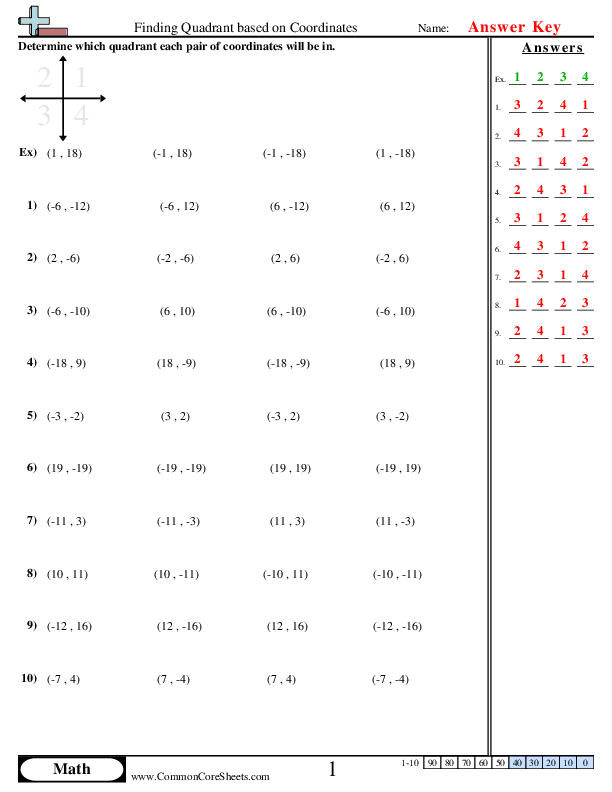
Finding Quadrant based on Coordinates
6ns6b


×
Description:
"This worksheet is designed to challenge children's understanding of math by finding the quadrant based on coordinates. With 10 diverse problems that utilize various coordinates, it helps sharpen children's skills in analyzing the quadrant of various points. Customizable based on your child's proficiency level, this educational resource can also be converted into flash cards for easy recall or used in distance learning setups, providing flexible and efficient learning approaches."

×
Student Goals:
Understanding of Quadrants and CoordinatesAfter completing this worksheet, students should have grasped the fundamentals of understanding the four quadrants of a Cartesian coordinate system. They should be able to identify which quadrant a point belongs to based on its coordinates. They would have developed a foundational understanding by practicing with different pairs of coordinates, thus gaining proficient knowledge of how each of the four quadrants is distinctly defined by negative and positive values of x and y coordinates.Enhanced Analytical SkillsThe worksheet would have honed students' analytical thinking skills. Decoding the quadrant from given coordinates is not just about applying a formula, but also about logically interpreting the values. Therefore, by consistently practicing problems of this nature, students inadvertently enhance their logical reasoning and analytical skills. They learn to pay close attention to detail and draw accurate conclusions based on the given data.Preparation for Advanced Mathematical ConceptsKnowing how to decipher quadrants from coordinates is a preliminary yet crucial step towards understanding more complex areas of mathematics. Completion of this worksheet would mean that the students are ready to delve into more advanced mathematical topics that require a good grasp of coordinates and the Cartesian system, such as geometry, vectors, and even calculus. This understanding provides them with a firm base, aiding them in solving more complex problems in the future.Application and Problem-Solving SkillsBy the end of this worksheet, students would also have an enhanced ability to apply their theoretical knowledge to practical mathematical problems. They should be able to read a coordinate pair, identify the quadrant, and use their findings to solve various math problems. This not only increases their adeptness at problem-solving but also boosts their confidence in handling more complex mathematical scenarios.Increased Confidence and Self-Efficacy in MathematicsFinally, successfully finding quadrants based on coordinates can bolster students' confidence in their mathematical abilities. Accomplishing such tasks can slowly but surely eliminate any math-related anxiety, fostering a healthy and positive attitude towards the subject. The confidence gained from overcoming challenges like these contribute to their overall self-efficacy, leading to better academic performance broadly over time.


Transforming On a Coordinate Plane
Link
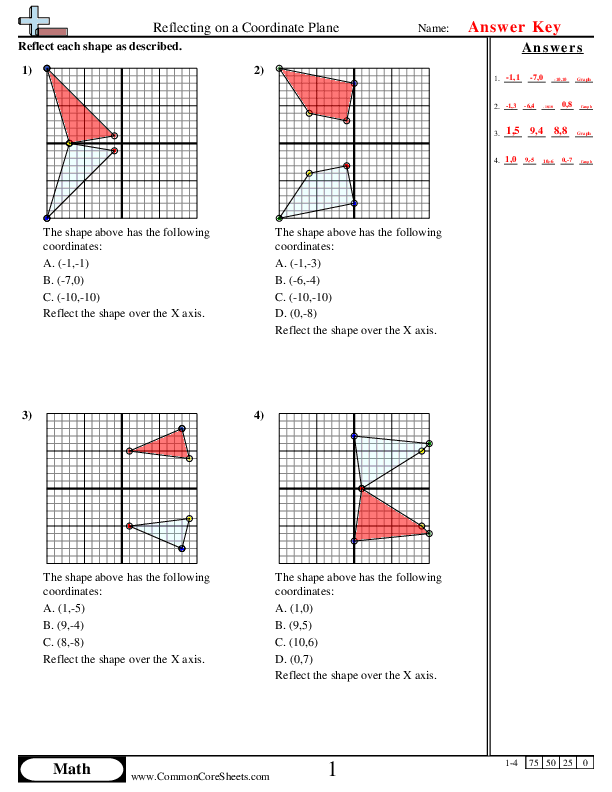
Reflecting on Coordinate Plane
8g3


×
Description:
"This worksheet is designed to enhance children's understanding of reflection in math, specifically on a coordinate plane. Covering four problems, it challenges learners to reflect different shapes over the X and Y axes using given coordinates. This versatile worksheet can be easily customized, converted into flashcards, or used for distance learning methods, making this an engaging, flexible learning tool."

×
Student Goals:
Understanding of Coordinate PlaneAfter completing this worksheet, students should have an enhanced understanding of the Cartesian coordinate plane. They will deepen their comprehension of both x and y axis, how they intersect, and how they are used to denote specific locations or points. This fundamental knowledge is crucial in not just mathematics but also in subjects such as physics and computer graphics. Additionally, students will gain an understanding of the positive and negative numerical values associated with each axis.Reflections on a Coordinate PlaneStudents will master the skill of performing reflections on a coordinate plane. Reflections are fundamental transformations in mathematics and involve flipping a shape across a certain line or axis, in this case, the Y axis. This exercise will help them to envision how a shape’s position changes with respect to a mirror image that is formed along an axis. Understanding reflections and being able to perform such transformations effectively is essential in geometry, trigonometry, and calculus.Enhancement of Analytical SkillsThe process of reflecting a shape requires a high level of analytical and critical thinking skills. Students will be trained to methodically analyse the given coordinates, determine new coordinates after reflection, and thereby enhance their problem-solving prowess. Furthermore, they will learn to meticulously examine and interpret the geometrical representations and the transformations that occur within the context of reflections.Improved Attention to DetailThrough the worksheet, students will improve their attention to detail as correct reflection of shapes requires accurate reading and transposition of coordinates. This not only helps in improving mathematical precision but also encourages them to be meticulous in other general aspects of learning.Preparation for Advanced ConceptsBy accomplishing this worksheet, students will lay a firm foundation for more advanced mathematical concepts. The knowledge and skills that the students acquire in this exercise would be a springboard for higher-level subjects like geometry, trigonometry, algebraic geometry, vector spaces in linear algebra, and many more.


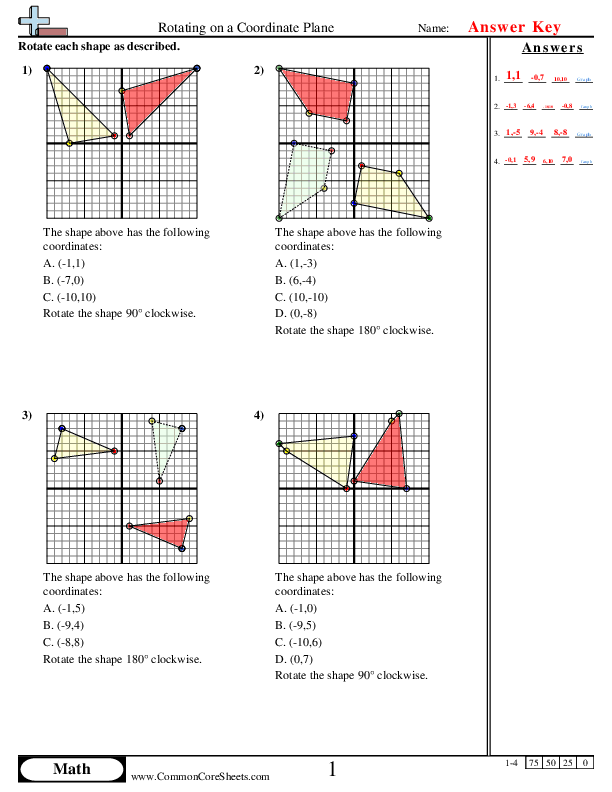
Rotating on Coordinate Plane
8g3


×
Description:
"This worksheet is designed to enhance children's understanding of rotations on a coordinate plane in math. It offers four problems that challenge learners to rotate shapes 180° or 270° clockwise or counterclockwise using given coordinates. Customizable and adaptable, it can easily be converted into flashcards for hands-on practice or utilized in distance learning frameworks."

×
Student Goals:
Master the concept of rotationAfter completing this worksheet, students should have a robust understanding of what it means to rotate an object on a coordinate plane. They will gain hands-on experience of turning shapes either 90 degrees or 270 degrees counter-clockwise. This will reinforce their concept of rotation and the effect it has on points in a plane.Deepen understanding of coordinate geometryIn working through the problems, students will get extensive practice plotting points on a plane. By noting the changes in the coordinates as they execute the rotations, they will deepen their grasp of coordinate geometry. This exercise will emphasize the relationship between the graphical representation and algebraic representation of geometrical shapes.Apply critical thinking abilitiesThis worksheet provides an excellent opportunity for students to apply their problem-solving and critical thinking abilities. They will need to interpret the problem, apply the concept of rotation, and carry it out accurately. This will enhance their analytical skills, ability to visualize geometric transformations and see spatial relationships.Enhance ability to follow instructionsWith specific instructions to rotate shapes by certain degrees, students will have to accurately follow the instructions to solve the problems. This practice will improve their ability to understand and adhere to specified guidelines, an important life skill that not only relates to mathematics but also to various other aspects of academics and life.Consolidate knowledge of anglesCarrying out 90 degrees and 270 degrees rotations will consolidate students' comprehension of angles. They will understand how a change in angle corresponds to a specific rotational movement, fortifying their understanding of angled rotations in a coordinate plane, and how different angles yield different rotations. This could be a practical application for their theoretical knowledge of angles.Strengthen precision and accuracyIn mathematics, precision and accuracy are crucial. As students pinpoint exact coordinates and execute precise rotations, they are honing their ability to work accurately and precisely. This skill, reinforced through the practice provided by this worksheet, will benefit students in all mathematical endeavors and is vital for success in more advanced mathematics.


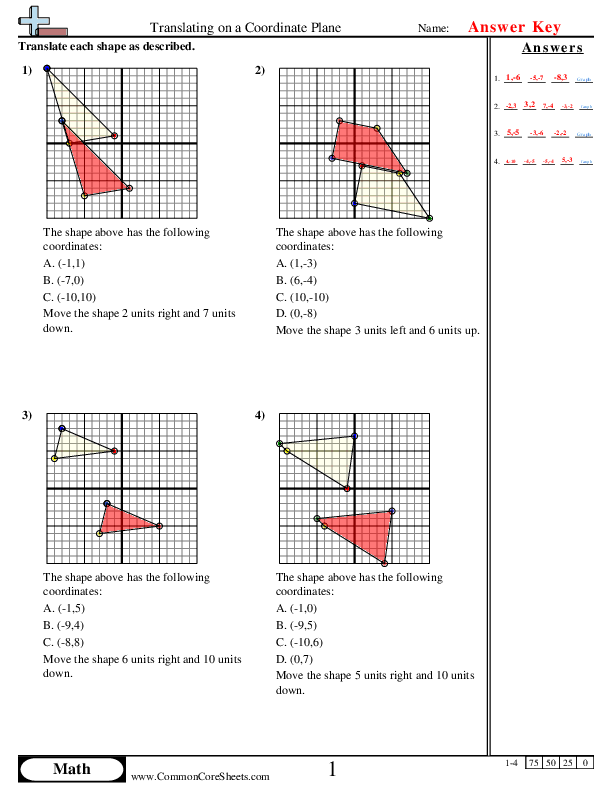
Translating on Coordinate Plane
8g3


×
Description:
"This worksheet is designed to enhance children's understanding of the coordinate plane in math. Featuring four problems, it teaches nuances of translating shapes by varying units up, down, left, or right. The content can be customized and converted into flashcards for added engagement. It's also suitable for distance learning, offering an interactive approach to grasp this important mathematical concept."

×
Student Goals:
Understanding of Coordinate GeometryAfter completing the worksheet, students will have gained a thorough grounding in coordinate geometry. They will comprehend the Cartesian coordinate system, concept of positive and negative coordinates, and the relationship between these coordinates and the position of a point in the plane.Manipulation of Geometrical Shapes on PlanesStudents will gain skills in manipulating, or moving geometrical shapes, on a plane. They will learn how to shift shapes, not just singular points, in different directions along the coordinate plane. They will develop the ability to move shapes up, down, left, and right by translating points on a coordinate plane.Skills in Translation of ShapesBy the end of this worksheet, students will have developed their skills in translation of shapes. They will understand how to translate a set of points to new positions in given direction and distance. They will be able to apply translation principles in mathematics and other related subjects.Problem-Solving AbilitiesBy completing this worksheet, students will enhance their problem-solving ability, a fundamental aspect in studying mathematics. They will face a series of computing challenges which they have to solve, thus they enhance their cognitive development and logical thinking.Practical Application of Mathematical KnowledgeStudents will be able to apply the knowledge gained practically. The skill of translating shapes on coordinate planes is critical in real-world applications such as computer graphics and game development. After mastering this skill, they can creatively apply it in varied contexts, boosting their interest and engagement in mathematics.



Finding Slope
8sp3


×
Description:
"This worksheet is designed to help children master the concept of Calculating Slope in math. It comes with 14 thought-provoking problems that range from simple equations like 'y = -8x + 1' to more challenging ones. The worksheet, customizable to suit individual learning styles, can easily be converted into flashcards for hands-on practice or modified for distance learning."

×
Student Goals:
Enhanced Problem Solving SkillsUpon completing the 'Calculating Slope' worksheet, students will have significantly improved their problem-solving skills. They will face various problems involving different scenarios and equations, which will challenge them to apply their theoretical understanding. By mastering this, students will develop a practical approach to solving problems and also bolster their computational thinking capabilities.Strengthened Understanding of SlopesThe children will gain a sound understanding of calculating slopes, a topic crucial in math. The ability to calculate the slope of a line, given an equation, is a fundamental aspect of algebra that lays a foundation for further advanced studies in mathematics. The students will comprehend how changes in variables affect the slope and learn to interpret these changes.Developed Math FluencyThe worksheet helps cement algebraic skills and mathematical fluency. The repetitive process of solving different problems using similar methods promotes the consolidation of skills, contributing to their math fluency. Increased fluency leads to automaticity, where students can solve problems efficiently without spending much mental effort on simple calculations.Greater Confidence in Handling AlgebraCompletion of the worksheet provides students with the confidence to tackle algebraic equations. By frequently engaging with these kinds of problems, they'll become more comfortable and less intimidated by algebraic equations. This confidence can translate to a better attitude toward the subject, increased participation in class, and improved performance in exams.Preparation for Advanced MathStudents completing the worksheet will be well-prepared for tackling more advanced mathematical problems in the future. The ability to calculate the slope is valuable in learning higher-order mathematical concepts and skills such as graphing linear equations, calculus, and physics. Mastering the calculation of slopes therefore proves instrumental in their mathematical educational journey.Improved Analytical SkillsThrough constant practice with the worksheet, students will improve their analytical thinking skills. The ability to analyse how changing values of x affect y is a critical aspect of logical thought that has applications beyond mathematics. Learning and understanding these relations can spur analytical thinking, benefiting children in various disciplines and real-life situations.



Identifying Same Slope
8ee6


×
Description:
"This worksheet is designed to foster children's understanding of math, focusing specifically on identifying the same slopes. It comprises five unique problems, encouraging real-world application of this crucial mathematical concept. The content can be easily customized to cater to individual learning needs, and can also be converted into Flashcards for more engaging studies. This resource can be effectively integrated into distance learning curriculum, providing flexible and accessible math education for all children."

×
Student Goals:
Understanding of SlopesStudents will develop a thorough understanding of mathematical slopes. They will be able to identify and compare slopes, thus deepening their knowledge of geometry. The completion of this worksheet should result in an increased comfort with the concept of slope, a core aspect of various branches of mathematics, including algebra, geometry, and even calculus in advanced stages.Problem-solving SkillsBy working through the problems on this worksheet, students will hone their problem-solving abilities. They will learn how to approach mathematical problems methodically and logically. They will also practice critical thinking skills, as they determine which options have the same slope, enhancing their ability to analyze and solve geometric problems effectively.Attention to DetailIdentifying the same slope requires careful attention to detail. Through this exercise, students will improve their precision and accuracy. They will get better at noticing subtle differences and master the art of meticulous mathematical observation. This skill will be beneficial not only within the realm of math problems but also in other academic domains and everyday life scenarios.Mathematical ConfidenceMath may be quite intimidating for many students. Completing this worksheet successfully will boost their confidence in their mathematical abilities and comprehension of complex concepts such as slopes. Overcoming challenges and solving problems correctly will enhance their self-efficacy in tackling mathematics, fostering a positive attitude towards the subject.Application of Mathematical ConceptsBy practicing and mastering the identification of the same slope, students will be better equipped to apply this concept in various real-life contexts. Slope is a key concept in understanding angles, directions, and rates of change which find application in a wide range of real-world scenarios like construction, aviation, and even game design, to name a few.




